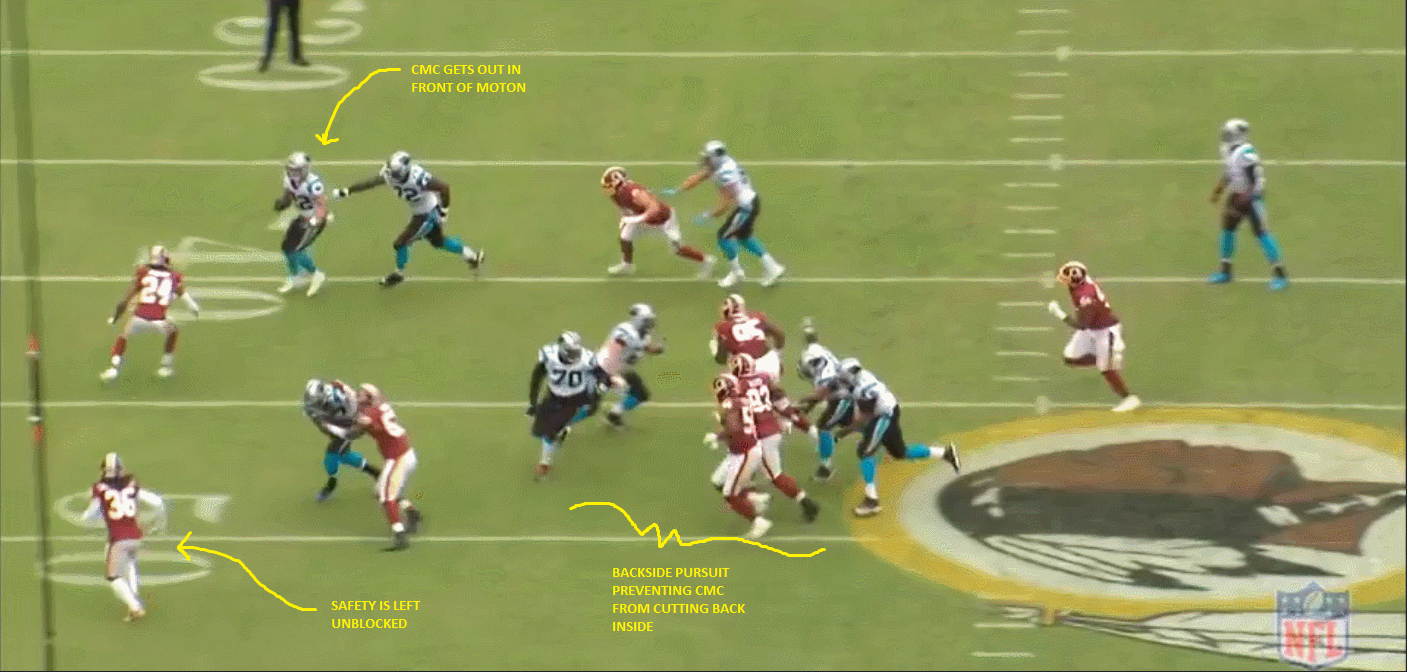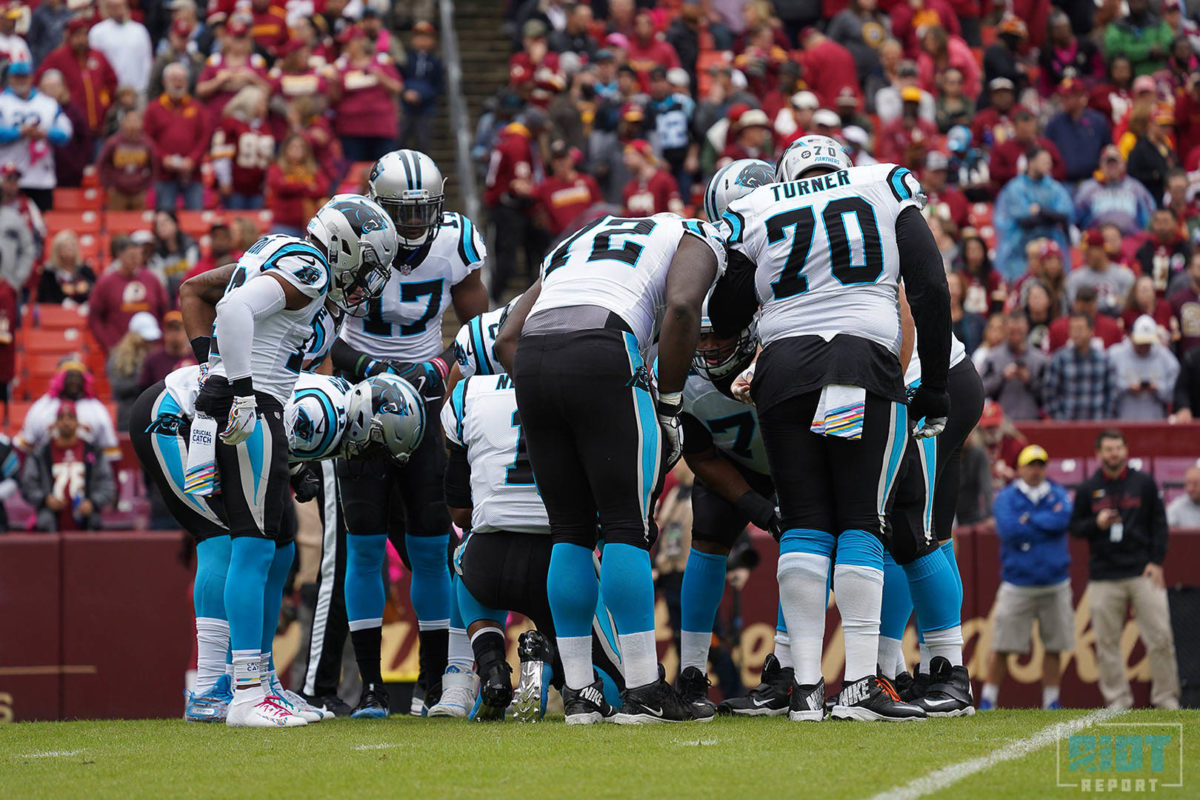The first part of this piece focused on plays from under center where, for the most part, the quarterback cannot be used as ball carrying threat in order to overcome a numbers advantage in the box on the part of the defense. While bootlegs and QB draws – or even QB power – are options, they are generally not things that offensive coordinators are happy calling consistently, at least in part because their success is dependent on taking the defense by surprise.
Therefore, for teams which have a quarterback capable of acting as a ball carrier, runs out of the shotgun are often utilized in order to use post-snap reads to overcome a loaded box. Whereas the plays in the first half against the Redskins often failed because of what was called, on all of the following plays, the Panthers have enough blockers such that the read on the final unblocked defender should allow the ball carrier a clear rushing lane into the second level of the defense. So why weren’t the Panthers able to take advantage of this against Washington?
From The Ground Up
On both of the following plays, the Panthers have one less blocker than the defense has box defenders – as was the case in the plays shown in part one – but unlike part one, both of these plays work out of the shotgun. First let’s look at the pre-snap alignments of the offense and defense:


In both cases, the Panthers have McCaffrey set off to the right of Newton, making it easiest for the plays to be run with the read on the right side of the play. Option plays like this can broadly be split into toss and read-options plays, with the toss plays looking to simply crash the offensive line away from the read and then simply read the edge defender – ideally on the second level – with read-options plays looking to create an inside and an outside running lane and then forcing a defender to chose which gap to fill. The Panthers could sensibly have run either on both of these plays, with an in-line and a second level defender on the read-side of both plays.
However, on both occasions the Panthers instead look to run a variant of the read-option, with the second-level defender being the read. It is important for the Panthers to vary how they look to apply these concepts to prevent defenses from cluing into these concepts, and the way in which they look to apply the core concept of the read options can be seen clearest in the below images:


Unfortunately, while these plays both look good on paper, neither of them worked in practice and, even more worryingly, they both went wrong in the same way:
On both of these plays, the Panthers have a tight end blocking down on the defensive end, and while this would have been fine if the read defender had gone inside to take the running back, but with the read defender staying outside, Newton correctly reads this and hands the ball off only for him to run into the edge defender that the tight end is trying to block. Superficially, this may seem like a mistake by the tight end, but the fact that both Olsen and Manhertz are unable to sustain this block raises another question – is this a reasonable block to ask a tight end to make against a player like Ryan Kerrigan?
This speaks to a larger issue in designing rushing plays, namely that blocking is really very difficult and that the most successful plays are often those which ask the least of the offensive line in order to be effective. On both of the plays above, the block that the tight end is being asked to make is far from simple, and while it is possible, relying on such a block for a play to function is tough. Instead, the Panthers may have had more success with simple read-option plays such as those shown below:


Or with toss-option plays, such as these:


I want to be clear that I am not saying that I am better – or even comparable – to Norv Turner as a play caller; that’s ridiculous. It is easy to stand at a distance and pick apart every last play, and there are certainly worse-designed plays out there – Mike Shula had a real taste for trying to pull multiple offensive linemen between tackle and guard – but what I’m saying is that if this play concept was something that Norv Turner was trying out on Sunday then it can probably be put on a shelf not to tried again. The Panthers might not have had great success on the ground in the past two weeks, but the success of the early weeks suggests that Turner is more than capable of designing an effective running game, with the option attack being a major part of that, but that doesn’t mean that every play he dials up is a keeper – he may be using these first few weeks as a trial to find the most effective use for both Newton and McCaffrey.
As well as this option concept, there was also a third down rushing play early on in the game where the play design put the Panthers in a position where they were going to struggle to succeed. Although this toss play didn’t use an option as such, the toss allowed them to leave the backside defensive end unblocked giving them an equal number of blockers to the defenders in the box. The pre-snap positions can be seen in the following image:

Off-screen to the right of the play (the left of the image), the Panthers have a one-on-one with Funchess and Norman, with a safety over the top. Again, on paper, the play appears to make sense, with Olsen and Funchess crashing inside to create a seam, with Moton then pulling outside to take Norman. On the inside of the play, Van Roten and Clark look to double the backside tackle and the outside linebacker, with Turner and Kalil doubling the front-side tackle before progressing on the safety.

As with the option concept shown earlier, this play unfortunately didn’t work in practice, and while it certainly wasn’t helped by the blocking on the back side of the play, the real issue came with the stretch blocks on the front side of the play. The play can already be seen to be falling apart at this point:

Both Olsen and Funchess actually did a nice job of creating an outside seam, but Moton simply couldn’t get across quickly enough to block Norman before he could get to McCaffrey – while McCaffrey might have helped him out by hesitating to set up the block, Olsen was always going to struggle to hold the defensive end for long and in reality, Moton is probably right where McCaffrey would ideally like to cut to. While McCaffrey would likely have been able to pick up the first down if Moton had been able to make this block without forcing McCaffrey to break stride, neither Kalil or Turner were ever going to be able to get a block on the safety:

This isn’t a terrible play, but by asking the offensive line to make these difficult blocks, Turner (perhaps) makes it harder to convert a very manageable third down than it needed to be.
Norv Turner hasn’t won multiple Super Bowls and stayed around in the NFL as long as he has without being able to design a good play, and as easy as it is to quibble with every last facet of every last play – as I admittedly just did – the Panthers’ offense has been a lot more functional in 2018 than it was under Mike Shula. The Panthers’ running game was excellent during the first three weeks of the season, and the issues shown here are far from unsolvable, but part of the issue with having just eight running back carries is that it only takes one or two sub-par plays for it to drag the performance as a whole down. Combine that with some plays that should have been checked out of and the Panthers had nearly half-a-dozen plays that were doomed from the start.
The final nail in the coffin, however, was some shoddy execution; but that will have to wait for part three.



